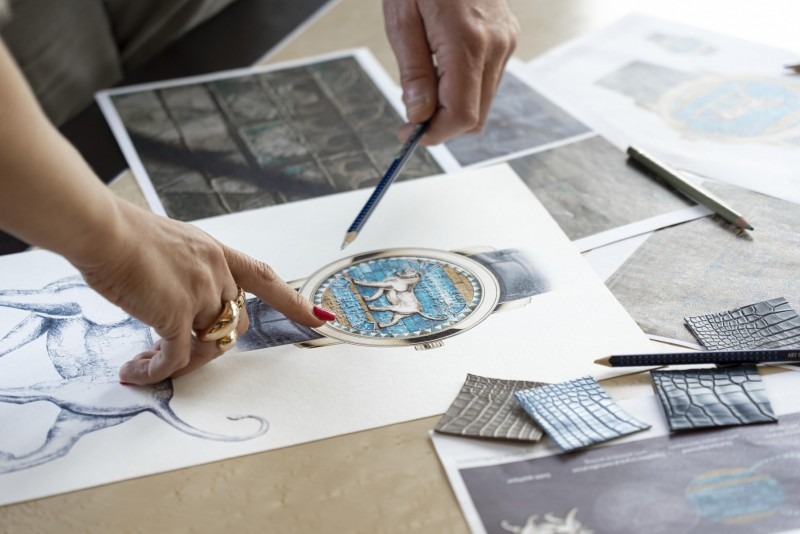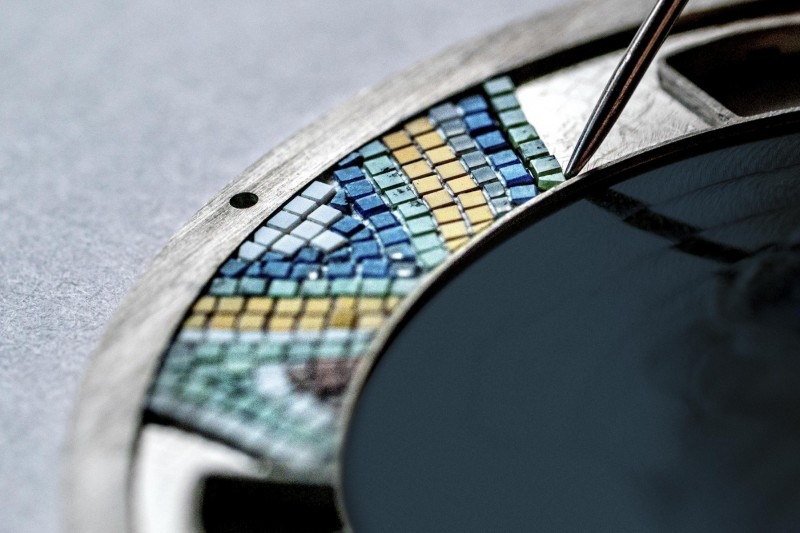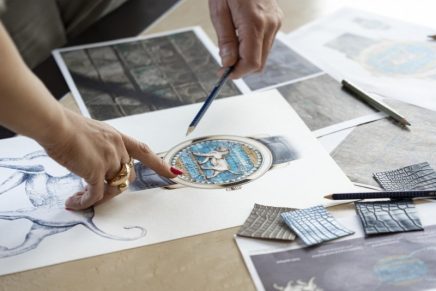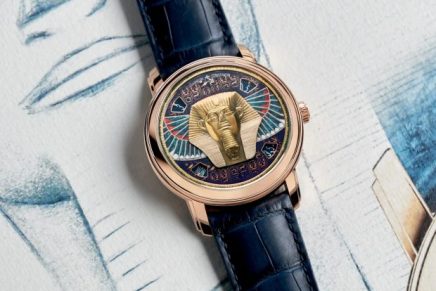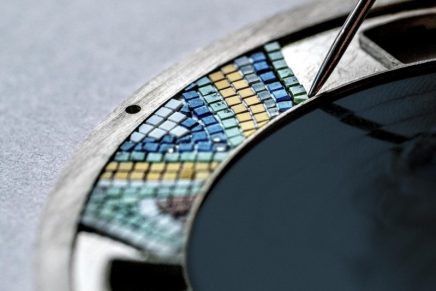Vacheron Constantin Métiers d’Art – Tribute to great civilisations: A dazzling collaboration with the Louvre.

Grand sphinx de Tanis – the Ancient Egyptian Empire (2035-1680 BC), Lion de Darius – the Persian Empire of the Achaemenids (559 – 330 BC), Victoire de Samothrace – Hellenistic Greece of the Antigonid dynasty (277 – 168 BC), Buste d’ Auguste – The Roman Empire of the Julio-Claudians (27 BC – 68 AD); @Vacheron Constantin Métiers d’Art – Tribute to great civilisations: A dazzling collaboration with the Louvre Museum, France
TRIBUTE TO GREAT CIVILISATIONS
In close collaboration with the Louvre’s museum teams, Vacheron Constantin‘s designers and developers have come together to create a new series of Métiers d’Art watches directly inspired by emblematic masterpieces of the Louvre.
The partnership between Vacheron Constantin and the Louvre has given rise to a series of Métiers d’Art watches paying tribute to the great civilisations of Antiquity. The Persian Empire of Darius the Great, the golden age of Ancient Egypt, the Hellenistic period of Ancient Greece and the rise to power of Augustus, the first Roman emperor, are the historical anchor points of Vacheron Constantin’s new Métiers d’Art watch series.
Vacheron Constantin’s Métiers d’Art collection is a unique opportunity to travel through time and space thanks to the talents of its master artisans. It is an opportunity to discover – or revisit – certain historical chapters or artistic and cultural symbols of our civilisations. From this perspective, the partnership initiated with the Louvre in 2019 offers an exceptional field of inspiration.
Vacheron Constantin, founded in 1755, and the Louvre, which opened its doors to the public some 40 years later, in 1793, share a concern for archiving, conservation and restoration, with the promise of perpetuating the related arts and crafts. This shared attachment to the splendours of the past and the transmission of knowledge has already paved the way for several joint initiatives by the two partners. Vacheron Constantin has supported the restoration of the clock named La Création du Monde, a masterpiece of 18th century precision horology presented to King Louis XV in 1754. The Maison also participated in a recent on-line Louvre auction by offering a single-piece edition Les Cabinotiers, whose dial was to reproduce in enamel an artwork kept in the museum and selected by its buyer. Another achievement was the discovery of the art workshops of the two institutions through a series of videos illustrating a parallel between the work of their respective master artisans.

Lion de Darius – the Persian Empire of the Achaemenids (559 – 330 BC); @Vacheron Constantin Métiers d’Art Tribute to great civilisations Lion de Darius watch
The siliceous glazed bricks decoration frieze of the Palace of Darius; a sphinx and paintings from an Egyptian coffin; the statue of the Victoire de Samothrace; and pieces of Greek ceramic objects; as well as a Buste d’Auguste and masterpieces of Roman mosaics served as models for this limited series of 20 (five of each variation). They are driven by in-house mechanical self-winding Calibre 2460 G4/2, which powers a disc-type indication of the hours, minutes, day and date around the dial periphery. This arrangement leaves ample scope for creativity and for these exceptional virtuoso compositions.
To power these Métiers d’Art Tribute to great civilisations watches, Vacheron Constantin has chosen its self-winding Manufacture Calibre 2460 G4/2, which features four discs indicating the hours, minutes, days and dates.
The apertures for reading the time and calendar indications, symmetrically positioned around the dial periphery, thus leave a vast field of expression for the artisans. No hands disturb the view of these miniature masterpieces. On the back of the movement, beating at a rate of 4 Hz (28,800 vibrations per hour) and comprising 237 components, the oscillating weight has also received special attention. It features a depiction – based on an 18th century lithograph – of the east facade of the Louvre and its magnificent colonnade inspired by the work of Louis Le Vau and Claude Perrault, based on an 18th century etching. The matrix of the design was hand-sculpted and then used to stamp the twenty oscillating weights composing the series.
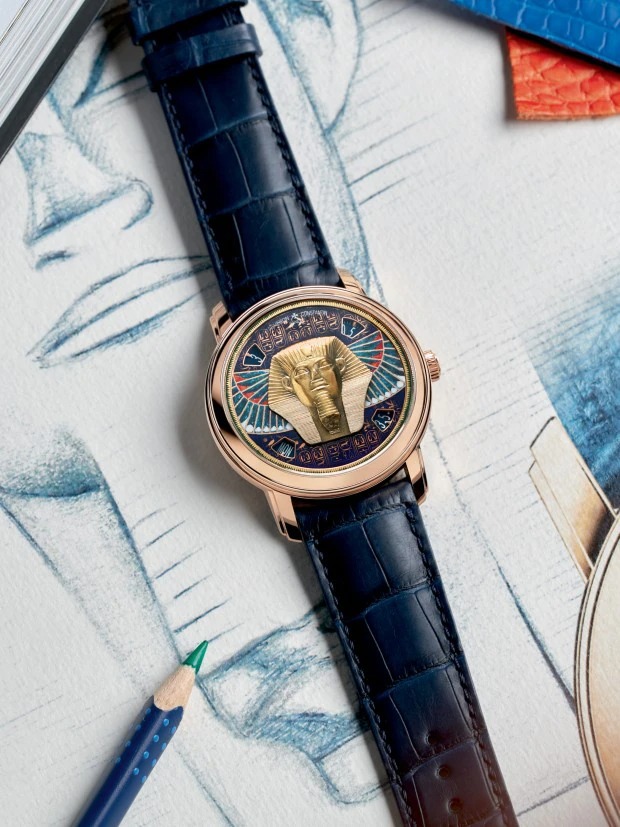
@Vacheron Constantin Métiers d’Art Tribute to great civilisations – Grand sphinx de Tanis watch x @Louvre
Vacheron Constantin Métiers d’Art Tribute to great civilisations – Grand sphinx de Tanis
Sphinx is the Greek word used to refer to Egyptian statues of lions with human heads. On this monumental Grand sphinx de Tanis model, the work of cutting the stone with polished surfaces is admirable in its precision. For the engraver of the carved gold applique representing the head of the sphinx, one of the difficulties – in addition to that of modelling the faces – lay in rendering the large false beard within such a small space. The master artisan had to work in relief using the pounced ornament technique, despite the thinness of the plate, before accentuating the depth effect by patinating the material with a blowtorch and then by hand.

@Vacheron Constantin Métiers d’Art Tribute to great civilisations – Victoire de Samothrace timepice x @Louvre Museum France
Vacheron Constantin Métiers d’Art Tribute to great civilisations – Victoire de Samothrace
This Victoire de Samothrace, Niké in Greek, is a peerless masterpiece of Hellenistic sculpture, due to the virtuosity of its white Parian marble carving and the ingenuity of its construction, which depicts a goddess standing on the bow of a ship. The centre of the main dial is enamelled in brown, a colour that is very difficult to achieve and required a mixture of rare enamels that are indeed no longer produced as well as six firings in the kiln. The periphery features grisaille enamelling depicting the decorative friezes taken from two Greek vases. These ceramic objects bearing red-painted geometrical figures feature various ornaments with foliage or geometric motifs, which are picked up on the dial.
The main dial is made of enamel whose deep colour, a mixture of blue and black enamels, is obtained after six firings in the kiln.
Vacheron Constantin Métiers d’Art Tribute to great civilisations – Buste d’Auguste
Shown wearing the oak headdress, Augustus appears older in this marble bust than in other crowned effigies, often linked to the date when he was honoured by the Senate with the civic crown in 27 BC. Whereas Augustus was 36 in this year marking the start of the Roman Empire, the portrait is that of a man in his fifties. The carved gold applique reproducing this Buste d’Auguste offers a striking sight in which the drape of the cape accompanying the breast plate, secured by a fibula, echoes the curling locks held by the oak crown.

@Vacheron Constantin Métiers d’Art Tribute to great civilisations – Grand sphinx de Tanis watch x @Louvre

